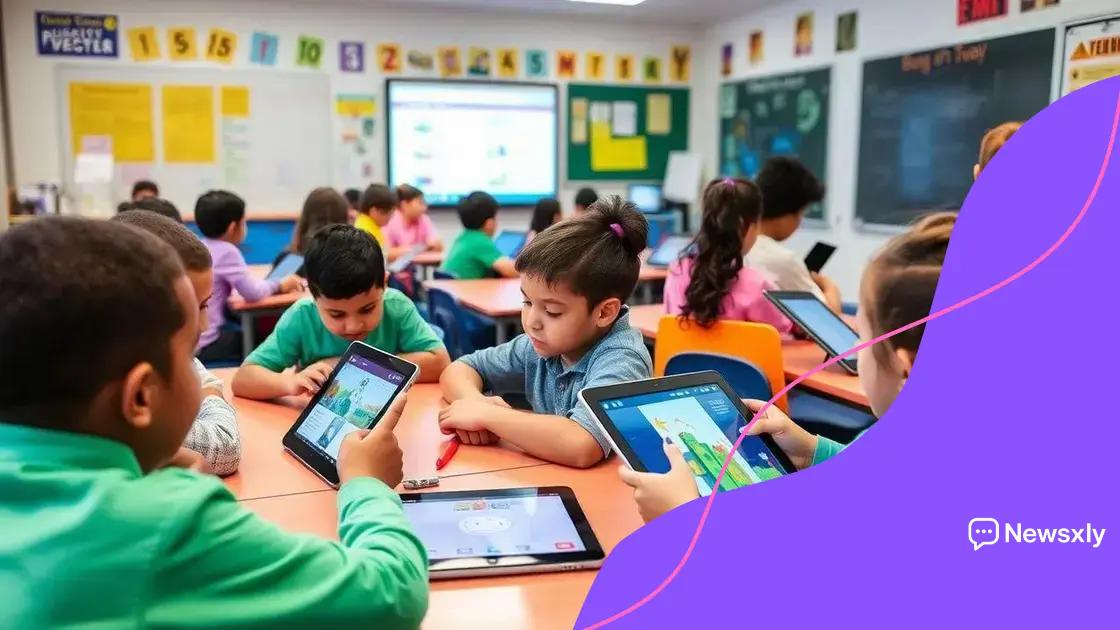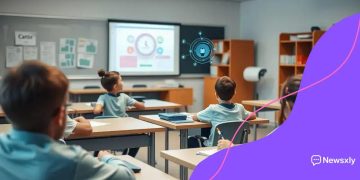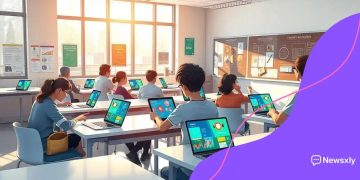Innovations in educational technology that transform learning

Innovations in educational technology, such as AI, virtual reality, and gamification, enhance personalized learning experiences, increase engagement, and prepare students for future challenges while addressing accessibility and technical challenges.
Innovations in educational technology have the potential to revolutionize how we engage with learning materials. Have you ever wondered how these advancements could impact your educational journey? This article delves into the exciting new tools and methods changing classrooms everywhere.
Understanding the role of technology in education
Understanding the role of technology in education is essential as we navigate a rapidly changing world. Technology has become a critical component that enhances learning experiences and promotes engagement among students.
To grasp its significance, we can explore several aspects of how technology is integrated into education.
Benefits of Technology in Education
Technology offers numerous advantages that support both teachers and students. Some key benefits include:
- Increased accessibility: Students can access learning materials anytime and anywhere.
- Personalized learning: Tools can adapt to individual learning speeds and styles.
- Enhanced collaboration: Technology enables students to work together effectively, regardless of location.
- Interactive learning: Engaging tools like simulations and games make lessons more dynamic.
Integrating technology can help students develop critical skills for the 21st century. For instance, many schools are adopting interactive platforms that facilitate real-time feedback. This immediate response allows educators to adjust their teaching methods quickly.
Moreover, the use of online resources and educational apps encourages students to explore topics beyond the classroom. With a wealth of knowledge available at their fingertips, students can dive deeper into subjects that interest them.
Challenges of Technological Integration
While there are great advantages, there are also challenges teachers face when incorporating technology. Some common obstacles involve:
- Budget constraints: Schools often have limited funds for technology upgrades.
- Training needs: Teachers may require additional training to effectively use new tools.
- Equity concerns: Not all students have access to technology at home, which can create disparities.
Despite these challenges, understanding the role of technology is crucial for educators. It is vital to foster an environment where learners can thrive in a tech-savvy world. When approached thoughtfully, technology can bridge gaps and create inclusive opportunities.
Key trends in educational technology today
Key trends in educational technology today are shaping how we approach learning. As technology evolves, its integration in education becomes crucial for both students and teachers.
Embracing interactive tools is one significant trend. These tools make learning engaging and help students grasp complex concepts quickly.
Personalized Learning
The rise of personalized learning platforms showcases another important shift. These platforms cater to individual student needs, allowing them to learn at their own pace. This flexibility encourages greater student engagement and motivation.
- Adaptive learning: Systems that adjust content based on student performance.
- Learning analytics: Using data to track progress and tailor lessons accordingly.
- Gamification: Incorporating game elements to enhance learning experiences.
Another prominent trend is the use of virtual and augmented reality in classrooms. By immersing students in interactive environments, these technologies make learning more tangible. For example, students can explore historical sites or conduct scientific experiments without leaving their classrooms.
Cloud computing also plays a vital role by providing accessible resources and collaboration tools. With cloud-based solutions, students can work on projects together, share documents, and access educational materials easily.
Focus on STEM Education
A growing emphasis on STEM (Science, Technology, Engineering, and Mathematics) education highlights the importance of these subjects in today’s world. Schools are integrating more hands-on activities that foster critical thinking and problem-solving skills.
- Coding programs: Teaching students programming from an early age.
- Robotics: Engaging students in building and programming robots.
- Project-based learning: Encouraging real-world applications of STEM concepts.
These trends reflect a broader movement towards modernizing education and preparing students for the future. With each advancement, educators are discovering new ways to integrate technology into their teaching while enhancing the learning experience.
Benefits of adopting innovative learning tools

The benefits of adopting innovative learning tools are significant and can transform the educational experience for both students and teachers. These tools enhance learning by making it more engaging and effective.
One of the main advantages is the ability to provide personalized learning experiences. Innovative tools can adapt to the needs of individual students, allowing them to progress at their own pace. This customization fosters a deeper understanding of the material.
Enhanced Engagement
Another key benefit is the increased engagement these tools bring into the classroom. Interactive learning technologies, such as educational games and simulations, capture students’ attention and encourage participation. When students are actively involved, they are more likely to retain the information being taught.
- Visual learning: Tools that incorporate graphics and animations can help clarify complex concepts.
- Real-time feedback: Many tools provide instant assessments, allowing students to understand their progress immediately.
- Collaborative features: Some platforms enable group work, promoting teamwork and communication skills.
Furthermore, adopting these tools can also prepare students for future job markets. As technology continues to advance, having experience with digital tools is crucial. Students can build skills that will be beneficial in their careers.
Innovative learning tools often come with analytics that allow educators to track student progress. This data can help teachers identify areas where students may need additional support. By understanding each student’s journey, teachers can tailor their instruction to better meet those needs.
Accessibility and Flexibility
Accessibility is another major benefit. Many learning tools are available online, allowing students to access education materials from anywhere. This flexibility can accommodate different learning environments, whether in classrooms or at home.
- Anytime learning: Students can review materials at their convenience, reinforcing their understanding.
- Diverse resources: A variety of formats, such as videos and articles, cater to different learning preferences.
- Increased participation: Students who may be hesitant to speak in class may feel more comfortable engaging online.
In summary, adopting innovative learning tools is essential for modern education. They not only make learning more enjoyable but also provide vital skills and insights that students will use throughout their lives.
Challenges educators face with new technologies
Educators face several challenges when integrating new technologies into their classrooms. These challenges can impact how effectively teachers use technology to enhance learning.
One major issue is the lack of training for teachers. Many educators are not adequately prepared to implement new tools or platforms effectively. Without proper training, they may struggle to use technology to its full potential.
Budget Constraints
Budget constraints also pose significant challenges. Schools often have limited funds to invest in the latest technologies. This can lead to inadequate resources, causing educators to work with outdated tools that do not meet current educational needs.
- Hardware limitations: Schools may not have enough devices for every student.
- Software costs: High-quality educational software may be too expensive.
- Maintenance issues: Keeping technology updated can strain school budgets.
Moreover, equity in access is a critical concern. Not all students have equal access to technology outside of school, which can create disparities in learning opportunities. Students who lack devices or reliable internet at home may fall behind their peers.
Another challenge educators encounter is student resistance to technology. Some students might prefer traditional learning methods and may be hesitant to engage with new tools. This resistance can affect their overall learning experience and limit the benefits of technology.
Technical Issues
Technical issues can also disrupt the learning process. Connectivity problems or software glitches can hinder lessons and frustrate both teachers and students. Having a reliable tech support system is crucial but often lacking in many schools.
- Slow internet connections: Can interrupt online activities and lessons.
- Compatibility problems: Some tools may not work well together.
- Insufficient IT support: Can lead to longer downtimes during technical failures.
Despite these challenges, educators are finding creative ways to overcome barriers and fully utilize technology in their teaching practices. By addressing training needs, improving access to resources, and fostering a positive attitude toward technology, educators can enhance the learning experience for all students.
Future possibilities for educational technology
The future possibilities for educational technology are exciting and hold great potential for transforming learning experiences. As technology continues to evolve, educators and students will benefit from innovative tools and methods that can significantly enhance education.
One promising area is the use of artificial intelligence (AI) in the classroom. With AI, personalized learning experiences can become even more tailored to the individual needs of students. This means that lessons could adapt in real time, based on student performance, ensuring that each learner receives the right level of challenge.
Virtual and Augmented Reality
Additionally, virtual reality (VR) and augmented reality (AR) technologies are expected to become more prevalent. By immersing students in realistic environments, these technologies can make learning interactive and engaging. Imagine students walking through ancient ruins or conducting complex science experiments as if they were in a lab, all from their classroom.
- Expanded learning environments: VR can transport learners to different places in an instant.
- Increased engagement: AR can overlay information on physical objects, enhancing understanding.
- Simulated experiences: Students can practice skills in a safe and controlled environment.
Another possibility lies in the growth of collaborative online tools. As classrooms become more connected, students can work on projects together from anywhere in the world. These tools can foster teamwork and allow students to share perspectives and ideas with peers from different cultures.
Furthermore, data analytics in education will likely play a major role in shaping the future of teaching. By analyzing student data, educators can identify trends and patterns, helping them to implement strategies that best address student needs. Real-time analytics can provide insights into what teaching methods are most effective.
Gamification of Learning
The gamification of education is also gaining traction. By incorporating game elements into lessons, educators can create a more engaging learning experience. Students will find challenges and rewards within their educational journey, making learning feel more like a game.
- Motivation boosts: Games can encourage students to strive for improvement.
- Enhanced retention: Fun elements can help solidify knowledge through repetition.
- Community building: Multiplayer games can foster a sense of belonging.
As we look to the future, the integration of these technologies into education promises to create a vibrant learning environment that engages and empowers students. With continuous advancements, the landscape of educational technology will continue to evolve, offering countless opportunities for growth and exploration.
FAQ – Frequently Asked Questions about Innovations in Educational Technology
What are the advantages of using AI in education?
AI can provide personalized learning experiences by adapting lessons to meet individual student needs, ensuring a more effective education.
How does virtual reality enhance learning?
Virtual reality immerses students in different environments, making complex subjects more tangible and engaging their interest.
What challenges do educators face with new technologies?
Common challenges include a lack of training, budget constraints, and issues with access and equity for all students.
Why is gamification important in education?
Gamification increases student motivation and engagement by turning learning into a fun and interactive experience, making retention of information easier.





